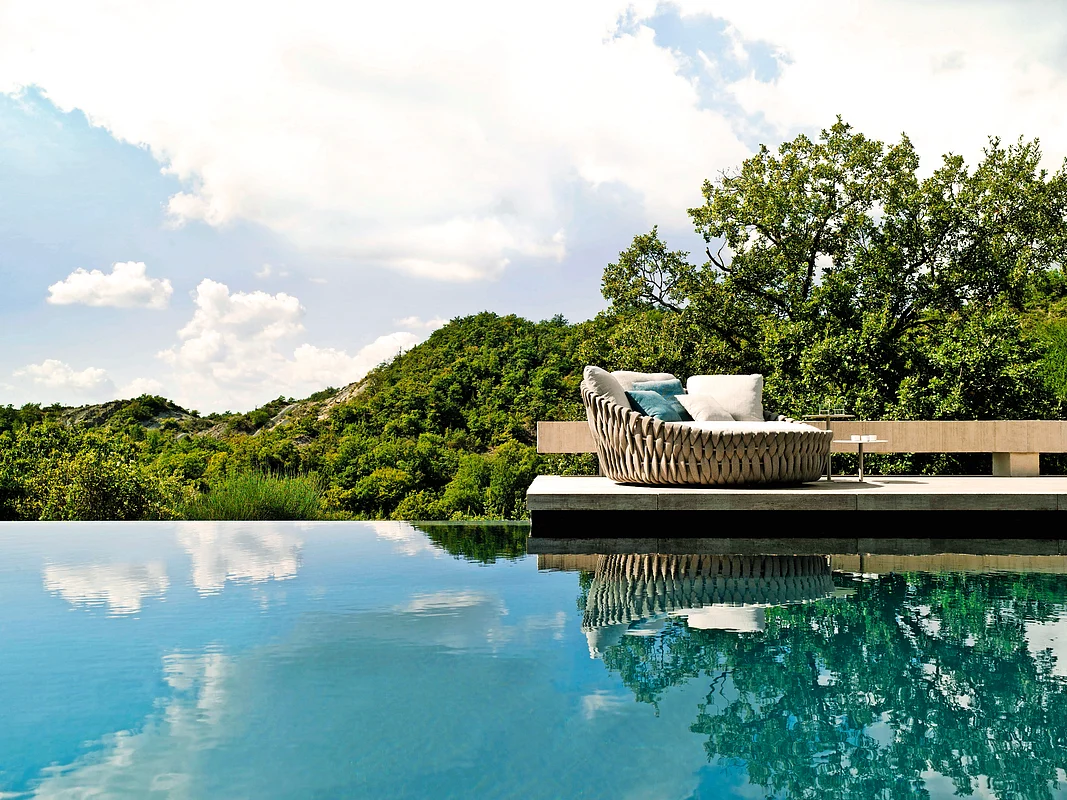
Outdoor spaces are evolving into essential extensions of modern homes, moving beyond leisure zones to fully integrated environments that blend effortlessly with interior spaces. Starting in 2026, the focus will shift to durable, high-performance and sustainable materials that maintain their beauty over time and set a new standard for functional and aesthetic outdoor living, says an industry veteran.
Monica Armani, an internationally renowned architect and designer, said technological advances and innovations will simplify processes and make outdoor living more natural and human-centered.
“I believe that outdoor spaces will become an increasingly integral part of contemporary life. Outdoor spaces will no longer be just transitional or leisure spaces, but environments designed to live daily life in continuity with the indoor space,” Monica told BTR during an exclusive interview.
The multi-award-winning Italian designer said the focus will be on increasingly high-performance and sustainable materials that can last for a long time without losing their beauty. Technological innovations will serve to make everything simpler, more natural and more humane.
“For me, the real trend will be this: design that combines comfort, authenticity and harmony with nature, bringing outdoor living into a state of deep balance and well-being.

Monica Armani is an acclaimed Italian designer whose influence extends across the global design landscape. Their multi-award-winning portfolio includes sophisticated indoor and outdoor furniture, objects and accessories for renowned brands, including Tribù, a Belgian, family-run outdoor design brand that produces exclusive outdoor furniture for private homes, elegant resorts and high-end projects worldwide. In Dubai, Tribù is exclusively represented by OBEGI, a regional leader in luxury furniture and interior design.
Talking about luxury outdoor design, trends and innovations, Monica said: “I love designing special outdoor spaces and with extensive outdoor furniture collections I can do it elegantly and functionally. A wide collection allows to solve a variety of environments with style. For me it is important to create a unique atmosphere and design spaces that become destinations in themselves,” said Monca in an interview with BTR.
For example, she said a dining area with a table and chairs, complemented by a beautiful rug and thoughtfully placed lighting, creates an intimate, sophisticated setting. Likewise, a living area under a veranda, furnished with sofas and armchairs, side tables and coffee tables, complemented by a carpet and other details, is a true luxury that nourishes the soul.
“My goal is always the same: to create spaces that evoke real emotions, where comfort and beauty exist naturally in a balance that makes you feel good.”

Material development has made enormous progress in recent years. Today we can use fabrics and upholstery that are extremely durable and weather-resistant, yet still feel soft and luxurious – just like interior materials. In addition, there are new weaving techniques and finishes that guarantee flawless aesthetics and longevity. Everything is designed to offer absolute comfort without sacrificing the lightness and elegance that characterize contemporary design.
Monica described Italian design as unique and balanced, saying it is the ability to constantly innovate while remaining timeless and contemporary.
“For me, Italian design is truly unique. It is a natural balance between functionality and beauty, born from a rich culture of art, architecture and exceptional craftsmanship. Its roots go back deep to the Renaissance, but its modern voice emerged in the post-war period with figures such as Gio Ponti and Achille Castiglioni – masters who transformed everyday life into acts of beauty and intelligence.”
“I was lucky enough to grow up with my father, a rationalist architect of the period, from whom I inherited a love of proportion, clean lines and essentiality. This heritage guides me every day in my work: in the search for lasting beauty and in promoting a dialogue between form, space and time. I believe that this is the secret of Italian design – the ability to constantly renew itself while remaining timeless and contemporary.”
Design philosophy and quality
Monica shared her views on product design philosophy and creative process without compromising on quality.
“Over the years I have developed my own design method, a personal philosophy that I call “Design in Molecules.” It represents the DNA of my creative approach: a balance between magic and logic, intuition and rigor,” she said.
“For me, quality comes precisely from this synthesis. It is the result of a process in which every choice – from proportions to technology, from materials to details – is made with coherence and precision.
“Logic creates function, structure and durability. Magic brings emotion, form and beauty. When these forces come together in harmony, a product is created that not only works well, but also inspires over time. To me, that is true quality.”
Monica also highlighted the importance of sustainable materials in high-quality furniture and said that design today has a responsibility to address global challenges with an integrated vision.

“A responsible project is inherently sustainable because it is designed to last: pure in form, functional in use and able to stand the test of generations without losing value or meaning.”
She believes that well-designed objects can last for decades. The Castiglioni brothers' Arco lamp is a perfect example: it was designed in 1962 and still illuminates not only rooms but also the minds of design lovers.
“For me, sustainability is not just about materials, but also about the culture of design. It's about making connections between technology, aesthetics and everyday life, and creating objects that improve the quality of life. It's not about chasing trends – it's about designing with intelligence and respect, focusing on excellence and beauty as universal values.”
Tribù collaboration
Speaking about her decades-long collaboration with Tribù, Monica said it was based on trust and paved the way for the brand's remarkable growth.
“My collaboration with Tribù began more than ten years ago when I met Koen De Cock, son of the founder and the driving force behind the brand's remarkable growth. From the beginning, we shared the same vision: essential, refined design for eternity. Over time, we have learned to work together with great ease, in a continuous dialogue of ideas, observations and developments that enrich each project,” she said.
It is an ongoing conversation based on trust and mutual listening that allows me to continually advance my research on the balance between form, function and emotion. This synergy has resulted in collections that best reflect our shared vision. Among many projects, the Tosca collection was the first chapter and became an icon of the sector: a fabric that combines tradition, technology and beauty in a purely Italian synthesis. The Ukiyo collection expresses lightness and purity in teak furniture. The Cesta armchair: an innovation that you don't see but feel. And many other pieces make every outdoor project unique and complete,” she added.
Architecture, furniture design
Monica also explained the intersection between architecture and furniture design, saying that both are inseparable disciplines and are rooted in the same philosophy.
“For me, architecture and design are one and the same. They come from the same way of thinking: creating life experiences through form, light and proportions. Each object is like a small habitable space, and each space is also made up of objects that complete it. This constant dialogue between architecture and design creates harmony, coherence and identity.”
“In this continuity I recognize my own approach: everything is part of a single language. It is a question of scale: my design method is like a photographic zoom, able to move from detail to landscape without losing the sense of the whole,” concluded Monica.

WHO IS MONICA ARMANI
Architect and designer Monica Armani was born into Italian rationalism, learning in her father's studio, where her own style was rooted in the tenets of that important movement: form follows function, scale and structure in balance, and minimal ornamentation.
Today, the DNA of Monica's own approach to her disciplined design process is expressed as “Design in Molecules,” reflecting the foundation of her learning, experience and commitment to excellence.
Industrial design is a natural evolution of these insights, and Monica's influence is felt and recognized throughout Italy and internally in her multi-award winning indoor and outdoor furniture designs, objects and accessories.
